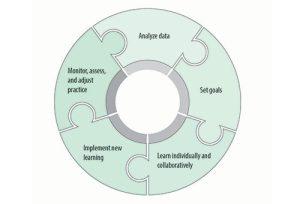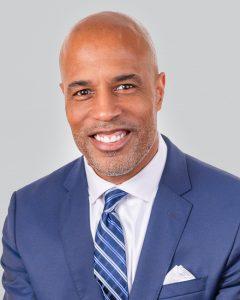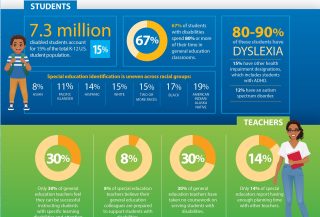CALL TO ACTION
Improvement cycles can change students’ lives
By Frederick Brown
Categories: Collaboration, Continuous improvement, Data, Standards for Professional LearningApril 2023
When people ask me how improvement cycles help teachers, I think back to when I was a teacher who didn’t know about improvement methods. In particular, I recall my second year as teacher, when I had a little knowledge, but not a lot. (You know what they say about a little knowledge.)
My students had challenges, and I worked hard to help them overcome those challenges, but I didn’t have a focused way of thinking about what to do. I would try an instructional strategy I had read or heard about, without any real sense of whether or why it would work for my particular students. I didn’t know if these approaches were making a difference until I received my students’ state test results at the end of the year. By then, I had tried so many different things that there was no way to tell what worked and for whom. Furthermore, the students had already moved on to the next grade.

My principal always commended me for being an innovative teacher, and I know I did some good for those students. However, I know I could have done more for them if I had engaged in improvement cycles — if I had collected more precise data about their needs, my strategies, and the results. I could have reflected and made timely adaptations to provide what they needed.
Things changed in my third year of teaching when I started planning common lessons with my fellow grade-level teachers. That marked a transition from working in isolation to behaving more like a learning community. Learning communities are essential to professional learning and improving practice, and they are an ideal forum for engaging in continuous improvement cycles.
In the 2022 version of Learning Forward’s Standards for Professional Learning, many of the elements of the standard we previously framed as the Learning Communities standard were embedded in the new Culture of Collaborative Inquiry standard, as was the importance of continuous improvement methods. This standard reads: “Professional learning results in equitable and excellent outcomes for all students when educators engage in continuous improvement, build collaboration skills and capacity, and share responsibility for improving learning for all students” (Learning Forward, 2022).
Collaborative learning communities are now at the center of my work, and I have used a collaborative lens to facilitate many improvement processes with districts and schools. One of my favorite continuous improvement models comes from Becoming a Learning Team, which illustrates and guides educators’ use of Learning Forward’s learning team cycle (Hirsh & Crow, 2017). The cycle has five steps:
- Analyze data.
- Set goals.
- Learn individually and collaboratively.
- Implement new learning.
- Monitor, assess, and adjust practice.
This cycle helps teams approach their day-to-day work with a different lens — an inquiry lens — that leads to more learning for everyone involved. That’s what improvement cycles are really about, whether you use Learning Forward’s learning team cycle, plan-do-study-act cycles, or another method.
Regardless of which method you use, I recommend paying attention to these do’s and don’ts as you go about the process of continuous improvement.
DO expand your data thinking.
Teams often limit their thinking about what kinds of data to analyze and reflect on, focusing primarily on student work, summative and formative assessments, and discipline data. But there are many other highly valuable sources of information. For example, a high school I worked with in Chicago spent a great deal of time monitoring which students spoke in which classes to look for trends in student engagement.
Here are other questions and data sources to consider that were recommended in Unconscious Bias in Schools: A Developmental Approach to Exploring Race and Racism (2019):
- Which students did I talk to today and call on this week, and are there any racial patterns?
- On school climate surveys and focus group discussions, how are student groups responding, and what are the trends?
- How often do students report witnessing intentional or unintentional acts of discrimination or prejudice?
I also remind teams to do what Hirsh and Crow recommend: Create safe spaces for these data conversations. They state, “Successful teams adopt norms that ensure the privacy of their conversations and eliminate the fear of reprisals for admitting they need help. They want every team member to be comfortable in examining all aspects of the data” (Hirsh & Crow, 2017).
DON’T skip the learning.
I’m always amazed how quickly teams skip the learning in their continuous improvement strategies. They plan, do, study, and act without really incorporating their insights and changing their work going forward. Hirsh and Crow (2017) urge teams to address the question, “How will we engage in learning to achieve desired outcomes for both ourselves and our students?” Asking this question as part of a cycle helps teams recognize that their learning is critical. Often, an examination of the teachers’ learning needs can help them more effectively address their students’ learning needs. For example, if data show many students aren’t performing well on a specific area of the formative assessment, could the learning gap be the teachers rather than the students? Without taking time to engage in the learning before the teaching, teams are potentially robbing their students of access to more effective practices.
Don't rush an improvement cycle. ''Without taking time to engage in the learning before teaching, teams are robbing their students of access to more effective practices.'' @fbrownLF #TheLearningPro Share on XAs part of this step, it’s also important to differentiate the learning for the adults based on what the data show. For example, if student engagement data for 6th-grade students in a school are concerning, it may not be necessary for every member of the team to engage in the same type of learning. Is engagement high in some classes but not in others? Could some team members benefit from specific coaching strategies while others receive more intensive support? Could one team member be a model for others in a school environment that has a culture of improvement and doesn’t have teachers who fear being put on a pedestal?
DON’T limit your use of an improvement cycle.
Teams tend to use improvement cycles to focus on traditional instructional strategies, but I’ve already offered some examples that go beyond those strategies to look at student voice and engagement. Improvement cycles can also be used to look at leadership strategies, district structures, and more. I encourage teams to make improvement cycles a part of how they do business.
I was impressed with a district team that used Learning Forward’s learning team cycle to examine a discipline policy that had long been in place in one of their high schools. When team members looked at their discipline data, they saw that Black and Brown students were disproportionately impacted by a policy that sent tardy students to in-house suspension. The staff wasn’t consistently applying the policy. As a result, Black and Brown students were missing classes and important learning experiences. After engaging in the learning team cycle, with a special focus on engaging in their own learning about alternative disciplinary strategies, the team overhauled the policy. The policy shift changed students’ lives at that school, and it might not have happened without the team’s engagement in an improvement cycle.
DO keep the cycles going.
I’ve heard educators say, “We used the cycle, and everything is great now. Problem solved.” But learning should never stop, and cycles shouldn’t stop, either. We should continue to generate and analyze data and refine our practices. I love to hear educators say, “The cycle helped us improve our process, and we realized we have so much more to learn. We’ll continue to keep an eye on the data.” I encourage all learning professionals to embrace that spirit and keep growing.
The work is never done. ''...Learning should never stop, and cycles shouldn’t stop, either. We should continue to generate and analyze data and refine our practices.'' Continuously. @fbrownLF #TheLearningPro Share on XDownload pdf here.
My Learning Forward colleagues and I are inspired by the Bill & Melinda Gates Foundation’s commitment to the spirit of continuous improvement, and we are grateful for their partnership that has allowed us to shine a light on collaborative cycles of improvement in this issue of The Learning Professional.
References
Benson, T.A. & Fiarman, S.E. (2019). Unconscious bias in schools: A developmental approach to exploring race and racism. Harvard Education Press.
Hirsh, S. & Crow, T. (2017). Becoming a learning team. Learning Forward.
Learning Forward. (2022). Standards for Professional Learning. Author.

Frederick Brown is Learning Forward’s president | CEO. Fred is an education visionary who knows firsthand that our nation’s schools need transformational change if we are to meet the challenges of the next decades. Fred advocates that every child deserves to reach their highest potential and every educator must have the opportunity to participate in exemplary, ongoing, professional learning programs to provide students the skills needed to meet their unique needs.
Supporting educators at all levels and improving student achievement are through lines of Fred's career. An elementary school teacher, a middle school assistant principal, and school principal, Fred saw firsthand the impact high-leverage instructional practices and school culture have on school success.
Fred is a frequent speaker on leadership and building high-quality learning in schools. He has co-authored two books that have made significant contributions to the field of education, demonstrating how a comprehensive approach to professional learning can be achieved so that everyone in a system is a learner, and how principals apply a learning lens to their many critical responsibilities to create a productive climate for learning and collaboration. "Becoming a Learning System" and "The Learning Principal -- Becoming a Learning Leader" are time-tested Learning Forward resources for schools and leaders.
Categories: Collaboration, Continuous improvement, Data, Standards for Professional Learning
Recent Issues
LEARNING DESIGNS
February 2025
How we learn influences what we learn. This issue shares essential...
BUILDING BRIDGES
December 2024
Students benefit when educators bridge the continuum of professional...
CURRICULUM-BASED PROFESSIONAL LEARNING
October 2024
High-quality curriculum requires skilled educators to put it into...
LEARNING TO PIVOT
August 2024
Sometimes new information and situations call for major change. This issue...












